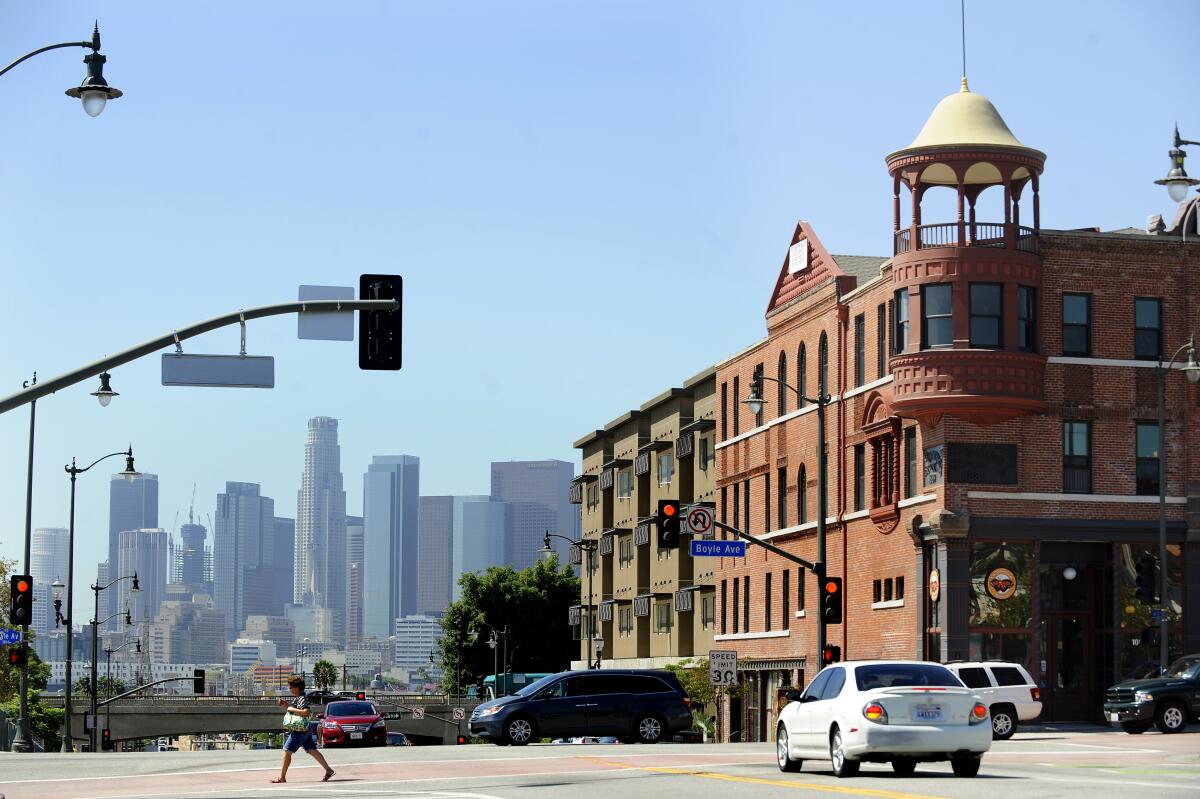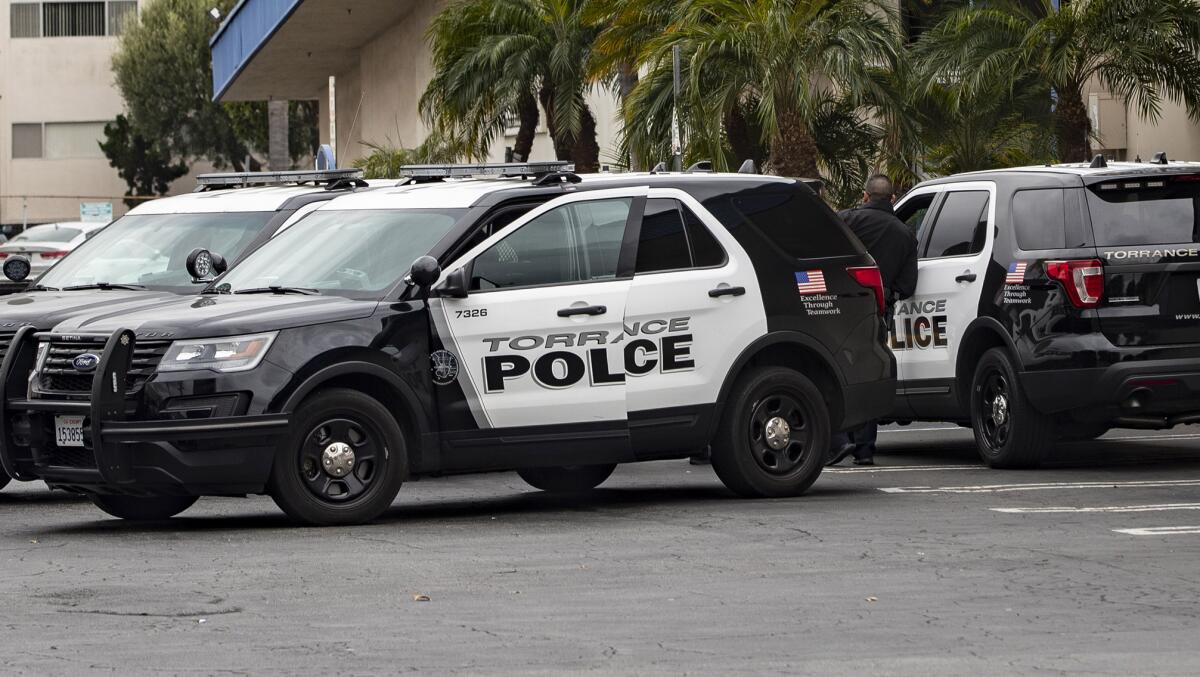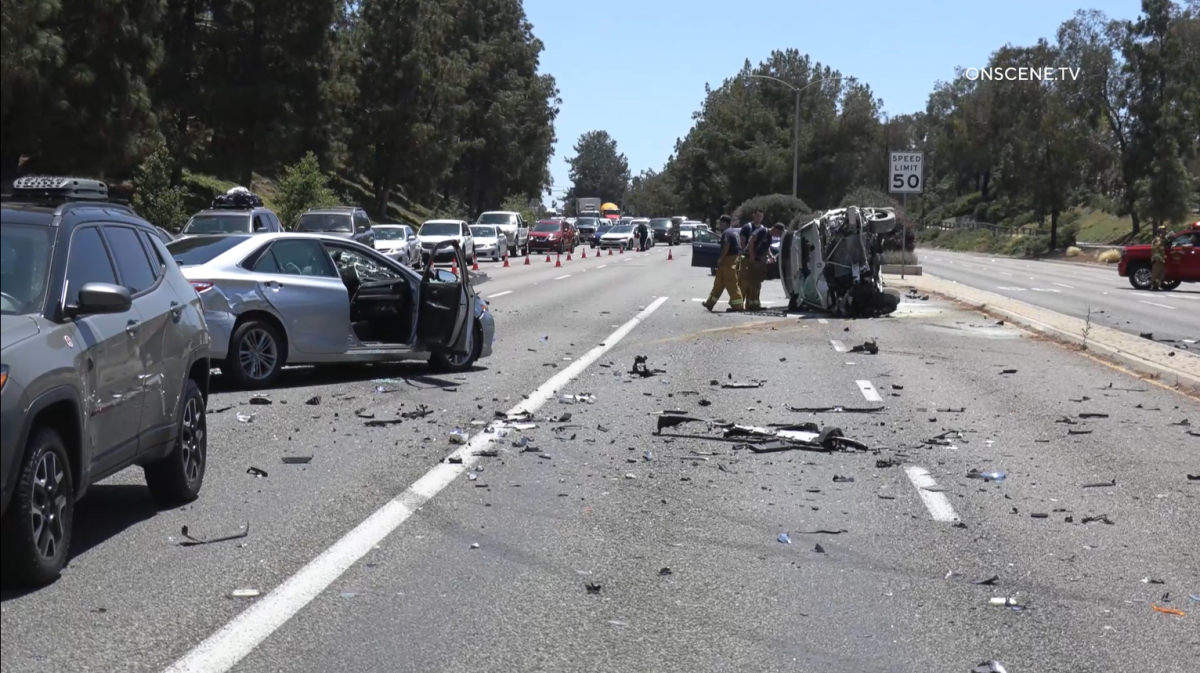Latinos are at center of two powerful projects by L.A. TACO., The Times

- Share via
Good morning, and welcome to the Essential California newsletter. It’s Thursday, Dec. 9. I’m Justin Ray.
Last month, I included an item about a nine-episode investigative podcast series called “The Sellout” that explains former Los Angeles City Councilman Jose Huizar’s fall from grace. The series — a collaboration between L.A.-based podcast company Neon Hum and L.A. TACO — centers on the Los Angeles Latino community. You get to hear from residents of Boyle Heights about how Huizar’s arrest amid a corruption probe was such a letdown for Angelinos who thought he was going to make a difference for their community.
The part I enjoyed most was the fourth episode, titled “Progress Over People,” about the construction of the Gold Line. While Huizar said the train would help Boyle Heights residents connect to the rest of L.A., that community began to question if it was actually meant to exacerbate gentrification. That’s because bus lines used by those residents were cut off or rerouted while the Metro expansion was taking place — for years. These factors hinted that the population actually being catered to was wealthier people who would replace current residents.
Latinos are also at the center of another series by the L.A. Times. Metro reporter Alejandra Reyes-Velarde looks at how the pandemic slammed the community with a particular ferocity. Her series looks at the impact on the largest ethnic group in California in three ways:
- COVID-19 threatens the state’s Latino middle class. Before the pandemic, about 38% of the state’s Latino population fell into a middle-class income bracket — slightly less than the percentage of white people, according to a report by the California Latino Economic Institute. But more than half of Latinos were in the lowest income bracket, and many in the middle class were at risk of slipping downward, said Mindy Romero, the report’s author. “If Latinos are left behind, that’s going to have a significant impact on California’s overall economy,” Romero said. “You can’t leave behind your most populous community.”
- Young Latinos are dying of COVID at an alarming rate. In California, Latinos age 20 to 54 have died from COVID-19 at a rate more than eight times greater than that of white people in the same age group, according to a study by USC’s Department of Preventive Medicine. As more people get vaccinated, pandemic restrictions lift and the economy rebounds, the families of the young Latinos who died will feel the loss for decades to come — not just the grief but the long-term financial hardships. It will be harder for their children to get an education and achieve upward mobility, potentially widening the ethnic-class divide in the coming decades.
- They were barely scraping by as janitors before COVID. Now, this family struggles to survive. There was a time when Glenda Valenzuela and her husband, Mario Alarcon, worked full time cleaning offices, schools and other buildings. With money from side gigs, they could take their children to a buffet or a movie night including popcorn and drinks. They dreamed of more: a bigger home in a neighborhood where their autistic eldest son could have better services and where Alarcon could expand his entrepreneurial spirit. It all seemed within reach for two immigrants without legal status — until the COVID-19 pandemic descended.
This year, The Times launched a section called “Latino Life,” featuring stories about Latinos, and by Latinos. I’m personally happy to see news outlets recognize the rich culture and importance of the community in Los Angeles. I remember I was at a lunch with columnist Carolina Miranda, who succinctly pointed out : “The city’s name is in Spanish!”
And now, here’s what’s happening across California:
But first: Oh my gosh! I did not expect to get a whole bunch of positive emails in response to my 6-month Essential California email I sent yesterday! I value all of your warm words. I received dozens of emails that helped me feel truly appreciated.
And on that note, I also want to express appreciation for someone who has been fundamental to putting this newsletter together every day. My editor Reed Johnson has been a game changer. Not only does he stop me from saying dumb things, he has helped me navigate the direction of this newsletter. When he became my editor, I enjoyed this job more than I ever did before.
Note: Some of the sites we link to may limit the number of stories you can access without subscribing.
L.A. STORIES
How L.A.’s oil boom shaped the city we know today. Edward Doheny wasn’t the first to find oil in the Golden State. But his 1892 oil strike in Los Angeles set in motion a spurt of economic and population growth, as well as pollution and environmental devastation. But the growth of the industry would take some time; roughly a quarter of a century would pass before the oil boom reached a fever pitch. “A lot of the people came to Los Angeles during the big boom [from] 1917 to 1925,” San Diego State history professor Sarah Elkind said, when “there was this enormous series of large [oil] strikes in the L.A. Basin.” Los Angeles Times
Explaining Hollywood: How to get a job as a TV director. Historically, network television was seen as creatively limiting, compared with film. But now, especially with the rise of streaming, television is not only widely respected but also where most of the job opportunities are. Why is the business so hard to break in? And how can you best prepare — so that one day a showrunner like Ava DuVernay might give you a call? Here’s some advice from experts in the field. Los Angeles Times
Our daily news podcast
If you’re a fan of this newsletter, you’ll love our daily podcast “The Times,” hosted every weekday by columnist Gustavo Arellano, along with reporters from across our newsroom. Go beyond the headlines. Download and listen on our App, subscribe on Apple Podcasts and follow on Spotify.
POLITICS AND GOVERNMENT
Kamala Harris and headphonegate. Politico opened a recent newsletter with an article about how Vice President Kamala Harris uses headphones instead of Bluetooth devices to make phone calls because she sees Bluetooth devices as a security risk. Although she was mocked on social media for her tech preferences, security researchers pointed out that Bluetooth has a number of well-documented vulnerabilities that could be exploited if a bad actor wanted to hack, say, the second most powerful person in American government. The Verge
The city of Sacramento ordered 160 vehicles to be cleared from a North Sacramento industrial park last week, and on Monday sent crews to the street to tow many of the vehicles and trailers that remained. Sacramento Mayor Darrell Steinberg raised concerns about the city’s decision to clear the vehicles, but it’s unclear whether the pushback will halt the process. “I believe living in unsupervised tent encampments is a health and safety crisis for the businesses and neighborhoods, but mostly people living in such conditions. From what I know, I disagree strongly with the timing and manner of this action over the last several days,” Steinberg said. Sacramento Bee
CRIME AND COURTS
Torrance police traded racist, homophobic texts. It could jeopardize hundreds of cases. The Times examined some of the until-now secret texts and identified a dozen Torrance police officers under investigation for exchanging them. The broad scope of the racist text conversations, which prosecutors said went on for years, has created a crisis for the Torrance Police Department and could jeopardize hundreds of criminal cases in which the officers either testified or made arrests. As the story reveals, the officers’ comments spared no color or creed. “What those text messages revealed was an extraordinarily hostile attitude toward people of color, people who are nonbinary, people who have different sexual orientations,” said Walter Katz, a former independent police auditor in California. Los Angeles Times
The death of an Oakland youth, and rising homicides. Family and friends all say Shamara Young had a warm, infectious smile and a relentlessly positive spirit. The 15-year-old was riding in a vehicle in Oakland when someone opened fire. She was killed in the shooting. Young’s life was cut down as she was working hard to boost her grades at Oakland’s Fremont High in hopes of playing basketball and going on to college. The year 2020 saw the largest one-year increase in murders since America started keeping nationwide records. Oakland is among the cities hardest hit. The rise in gun violence and homicides has left many residents angry, fearful and calling on city leaders and law enforcement to do more. NPR

Support our journalism
HEALTH AND THE ENVIRONMENT
Car crash deaths have surged during COVID-19 pandemic. Here’s why. It was a tally that shocked the experts: 38,680 deaths on U.S. roadways last year, the most since 2007 even though pandemic precautions had dramatically reduced driving. Experts say that behavior on the road is likely a reflection of widespread feelings of isolation, loneliness and depression. “We might decide: What does a seatbelt or another beer matter, anyway, when we’re in the middle of a pandemic?” said Shannon Frattaroli, a researcher at Johns Hopkins Bloomberg School of Public Health. The rise in motor vehicle deaths lines up with other pandemic-era trends: Alcohol sales have soared, drug overdoses have set new records, and homicides have seen their biggest increase on record. Los Angeles Times

About 34,000 students have not yet complied with the COVID-19 vaccine mandate in the Los Angeles Unified School District — and there’s no longer enough time for students who have not gotten their first shot to be fully vaccinated by the Jan. 10 start of the second semester, portending significant disruption to their education as they will be barred from campus. The high number of students who will not be able to meet the full inoculation deadline is likely to force difficult decisions on leaders of the second-largest U.S. school system. Los Angeles Times
CALIFORNIA CULTURE
Should you pay an extra fee just for being a Californian? Pizza Hut thinks so. California is an expensive state for businesses — no one disputes that. But a Times reader sent columnist David Lazarus a screenshot of a recent transaction with a Pizza Hut restaurant. It included a 76-cent “service charge” that “partially offsets the increased cost of operations in the state of California.” But Lazarus calls this “sheer dishonesty,” and simply a company “trying to pull a fast one on customers by imposing a stealth price hike in the form of an added fee, rather than charging a list price that reflects actual business costs.” The chain is owned by Yum Brands. Their spokesperson said Pizza Hut franchisees “are responsible for setting their own menu prices, delivery fees and service charges.” Los Angeles Times
Free online games
Get our free daily crossword puzzle, sudoku, word search and arcade games in our new game center at latimes.com/games.
CALIFORNIA ALMANAC
It looks pretty dreary!
Los Angeles: Rainy, 56 San Diego: Rainy, 60 San Francisco: I didn’t know foxes giggle! Sunny, 56 San Jose: Overcast, 58 Fresno: Rainy, 52 Sacramento: Rainy 55
AND FINALLY
Today’s California memory is from Carol Bartlett:
For Christmas 1959 my family stayed in an old lodge at Big Bear, near the lake. There was a gentle hill with a rope tow. On borrowed skis I went every day, never seeing anyone but the ranger in his hut. Straight up - straight down. A couple of years later, I found out that skiing involves learning how to turn.
If you have a memory or story about the Golden State, share it with us. (Please keep your story to 100 words.)
Please let us know what we can do to make this newsletter more useful to you. Send comments to essentialcalifornia@latimes.com.
Sign up for Essential California
The most important California stories and recommendations in your inbox every morning.
You may occasionally receive promotional content from the Los Angeles Times.




